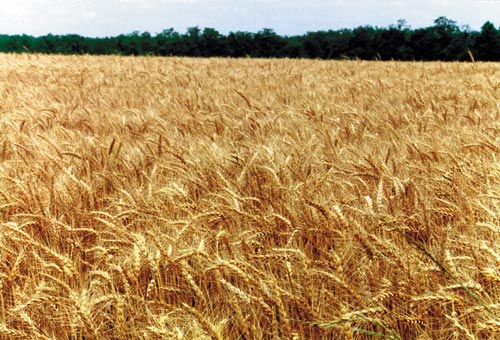October 22, 2010

In late October, Arkansas wheat growers are planting seed into the dust in hopes the odds for rainy weather will be in their favor, according personnel with the University of Arkansas Division of Agriculture.
The stakes are high for would-be wheat growers. Seed was in short supply this fall and what seed growers could obtain was expensive. While the dry fall has been terrific for harvest, it’s left the ground too dry to plant wheat.
“Growers that are planting (during the week of October 18) in hopes of rain this weekend or next week – this is a one-shot deal. There is no ‘do over’,” said Scott Stiles, Extension economist with the University of Arkansas Division of Agriculture.
The good news is an improving forecast. According to the National Weather Service at Little Rock, there’s a 40 percent chance of rain Saturday night, increasing to 50 percent on Sunday, including the potential for severe weather. A chance of rain will linger through much of next week.
Should the rain come and give Arkansas growers a good start to their winter wheat stands, the payoff should be worth the gamble.
“Wheat prices continue to impress,” Stiles said. “July 2011 wheat futures have closed above $7 for all but one day this month.”
On Oct. 21, the contract closed at $7.35 a bushel and “new crop wheat prices have rallied about $2 per bushel since mid-June. Growers can currently lock in a price of $6.75 per bushel for delivery to Mississippi River terminals next June.”
Crop problems in Eastern Europe, Russia, and Canada have reduced world wheat supplies this season. Though there are no wheat supply concerns in the United States, the futures market is focused on shortages in key foreign wheat producing regions.
The same countries that suffered wheat production losses also had yield loss in other grains. “As a result, there could be some shifting to wheat for use as a feed alternative to corn over the coming months,” Stiles said.
The fear of grain shortages in 2008 is vivid memory for some governments around the world. There are export bans or restrictions in countries such as China, India and Russia. Wheat supplies available to the rest of the world have tightened as a result of these actions too.
In southwest Arkansas, “a few producers have dusted their wheat seed into dry fields hoping they would receive a good rain to bring it up,” said Joe Vestal, Lafayette County Extension Staff Chairman. “We did receive some rain this week, anywhere from 0.5 to 1.2 inches depending on location.
“Wheat seed of the high performing varieties is very hard to find. Growers here are having to plant whatever they can find.”
Vestal said seed costs are as high as $16 to $20 per 50-pound bag. “Growers who procured seed earlier were able to buy seed for $12 to $14 per 50-pound bag.”
In southeast Arkansas, Chad Norton, Lincoln County Extension staff chair, said many of the growers in his county are more interested in another commodity, as prices continued to head upward.
“Most of our producers are still looking at the soybean price for next year and would rather grow full season soybeans for that price than to try to double crop them after wheat,” said Norton. “I've had a couple that have said that they were not going to pay what the (seed) dealers wanted and it kept them from planting any wheat.”
Norton added that “they weren't real gung-ho on wheat anyway so it gave them the reason they wanted not to plant it.”
In Phillips County, along the Mississippi River, growers are just biding their time.
“The farmers over here … (want) to plant wheat but most are waiting for more moisture,” said Robert Goodson, county Extension agent. “But the majority are really not worried yet. They understand that it is only Oct. 21 and they have the month of November to get the seed in the ground.
“Dry weather may be beneficial because it delayed planting to the recommended planting time. Seed is in short supply and many are using whatever seed they can find.”
In northeastern Arkansas, it’s a mixed bag. Randy Chlapecka, Jackson County Extension staff chair, said the county hadn’t received a decent rain since Sept. 11.
“One producer planted for a rain, but when he saw that some of his seed was germinating and some was not, he ran his center pivots for irrigation to get uniform germination and emergence,” said Chlapecka. “Other farmers are waiting for enough rain to get moisture to plant.
“Some I have talked to are about to the point of throwing in the towel. If they don’t get significant rain soon they probably will not plant, as yield potential starts going down as we get into November.”
According to the National Agricultural Statistics Service winter wheat was 20 percent planted and 5 percent emerged. That compares with the five-year averages of 27 percent for planting and 10 percent for crop emergence.
For more information on crop production, visit www.uaex.edu or contact your county Extension office.
You May Also Like




